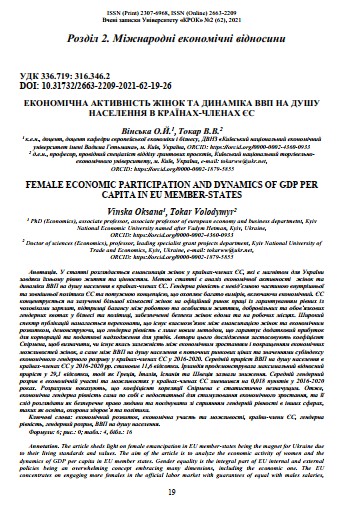ЕКОНОМІЧНА АКТИВНІСТЬ ЖІНОК ТА ДИНАМІКА ВВП НА ДУШУ НАСЕЛЕННЯ В КРАЇНАХ-ЧЛЕНАХ ЄС
DOI:
https://doi.org/10.31732/2663-2209-2021-62-19-26Ключові слова:
економічний розвиток, економічна участь та можливості, країни-члени ЄС, гендерна рівність, гендерний розрив, ВВП на душу населенняАнотація
У статті розглядається емансипація жінок у країнах-членах ЄС, які є магнітом для України завдяки їхньому рівню життя та цінностям. Метою статті є аналіз економічної активності жінок та динаміки ВВП на душу населення в країнах-членах ЄС. Гендерна рівність є невід’ємною частиною внутрішньої та зовнішньої політики ЄС та потужною концепцією, що охоплює багато вимірів, включаючи економічний. ЄС концентрується на залученні більшої кількості жінок на офіційний ринок праці із гарантуванням рівних із чоловіками зарплат, підтримці балансу між роботою та особистим життям, добровільних та обов’язкових гендерних квотах у бізнесі та політиці, забезпеченні безпеки жінок вдома та на робочих місцях. Широкий спектр публікацій намагається переконати, що існує взаємозв’язок між емансипацією жінок та економічним розвитком, демонструючи, що гендерна рівність є лише новим методом, що гарантує додатковий прибуток для корпорацій та податкові надходження для урядів. Автори цього дослідження застосовують коефіцієнт Спірмена, щоб визначити, чи існує якась залежність між економічним зростанням і покращенням економічних можливостей жінок, а саме між ВВП на душу населення в поточних ринкових цінах та значеннями субіндексу економічного гендерного розриву у країнах-членах ЄС у 2016-2020. Середній приріст ВВП на душу населення в країнах-членах ЄС у 2016-2020 рр. становив 11,6 відсотки. Ірландія продемонструвала максимальний відносний приріст у 29,1 відсотки, тоді як Греція, Італія, Іспанія та Швеція зазнали зниження. Середній гендерний розрив в економічній участі та можливостях у країнах-членах ЄС зменшився на 0,018 пунктів у 2016-2020 роках. Розрахунки показують, що коефіцієнт кореляції Спірмена є статистично незначущим. Отже, економічна гендерна рівність сама по собі є недостатньої для стимулювання економічного зростання, та її слід розглядати як безперечне право людини та поєднувати зі сприянням гендерній рівності в інших сферах, таких як освіта, охорона здоров’я та політика.
Завантаження
Посилання
Agarwal, B. Gender Equality, Food Security and the Sustainable Development Goals. Current Opinion in Environmental Sustainability. 2018. 34, 26-32.
Closing the Gap: The EU Pay Transparency Directive. URL: https://www.bakermckenzie.com/en/insight/publications/2021/03/eu-pay-transparency-directive.
GDP per Capita in EU Member-states. URL: https://ec.europa.eu/eurostat/web/national-accounts/data/database.
Gender Equality Strategy 2020-2025. URL: https://ec.europa.eu/info/policies/justice-and-fundamental-rights/gender-equality/gender-equality-strategy_en.
Global Gender Gap Report 2017. URL: http://www3.weforum.org/docs/WEF_GGGR_2017.pdf.
Global Gender Gap Report 2018. URL: http://www3.weforum.org/docs/WEF_GGGR_2018.pdf.
Global Gender Gap Report 2020. URL: http://www3.weforum.org/docs/WEF_GGGR_2020.pdf.
Global Gender Gap Report 2021. URL: https://www.weforum.org/reports/global-gender-gap-report-2021.
Johnson N. L., Kovarik C., Meinzen-Dick R., Njuki J., Quisumbing A. Gender, Assets, and Agricultural Development: Lessons from Eight Projects. World Development. 2016. 83. 295-311.
Kabeer N. Gender Equality, Economic Growth, and Women’s Agency: the “Endless Variety” and “Monotonous Similarity” of Patriarchal Constrains. Taylor and Francis Journals Feminist Economics. 2016. Vol. 22. Issue 1. 295-321. URL: http://www.tandfonline.com/doi/full/10.1080/13545701.2015.1090009?scroll=top&needAccess=true.
Mitra A., Bang J.T., Biswas A. Gender Equality and Economic Growth: Is It Equality of Opportunity or Equality of Outcomes? Taylor and Francis Journals Feminist Economics. 2015. Vol. 21. Issue 1. 110-135. URL: https://ideas.repec.org/a/taf/femeco/v21y2015i1p110-135.html.
Portalatin J. Technology Could Destroy More Jobs for Women Than Men. URL: http://fortune.com/2017/01/28/automation-workers-women-pay-gap/.
Theriault V., Smale M., Haider H. How Does Gender Affect Sustainable Intensification of Cereal Production in the West African Sahel? Evidence from Burkina Faso. World Development. 2017. 92. 177-191.
Вінська О.Й., Токар В.В. Взаємозалежність гендерної рівності та інноваційної конкурентоспроможності країн ЄС. Глобальні та національні проблеми економіки. 2016. № 12. С. 18-22. URL: http://global-national.in.ua/archive/12-2016/6.pdf.
Вінська О.Й., Токар В.В. Гендерна рівність та соціально-економічний розвиток країн-членів Європейського Союзу. Східна Європа: економіка, бізнес та управління. 2016. №2. С. 32-36. URL: http://www.easterneurope-ebm.in.ua/journal/2_2016/08.pdf.
Вінська О.Й., Токар В.В. Політична емансипація жінок як фактор економічного розвитку країн ЄС. Науковий вісник Херсонського державного університету. 2016. Вип. 18. Ч. 1. С. 17-21. URL: http://www.ej.kherson.ua/journal/economic_18/1/5.pdf.

Downloads
Опубліковано
Як цитувати
Номер
Розділ
Ліцензія

Ця робота ліцензується відповідно до Creative Commons Attribution 4.0 International License.

